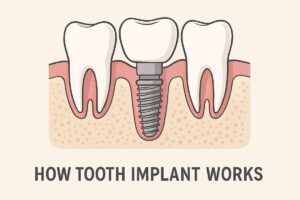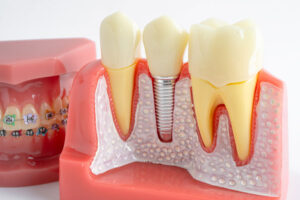If you’re wondering how tooth implant works, this guide will walk you through the whole process in plain language. You’ll learn what an implant is, a step‑by‑step timeline from consultation to final crown, common risks, basic aftercare, and how to find a provider. By the end, you’ll have clear next steps and know when to schedule a consultation.
What is a tooth implant?
A tooth implant is a small titanium screw placed into the jawbone to replace a missing tooth root. The implant acts as a stable anchor for a crown, bridge, or denture. Implants are designed to look and feel like a natural tooth.
Key benefits include:
- Stability for chewing and speaking
- Preserves jawbone by stimulating bone like a natural root
- Natural appearance and long-term durability
How tooth implant works: Step-by-step
Consultation & planning
The process begins with an exam and X-rays or a CBCT scan to check bone and nearby structures. Your dentist or implant specialist will review your medical history and make a treatment plan. This step determines if you need a bone graft or other preparatory work.
Implant placement (surgery)
Implant placement is a minor surgical procedure done under local anesthesia. The dentist creates a small opening in the gum and places the titanium implant into the jawbone. Most single‑implant placements take 30–60 minutes. You may get a temporary tooth if appearance matters right away.
Healing and osseointegration
After placement, the jawbone grows around the implant in a process called osseointegration. This bonding is crucial for long-term success and usually takes about 3–6 months. During this time avoid heavy chewing on the area and follow your provider’s care instructions. Proper healing is why many people ask specifically about how tooth implant works—this bone bonding is the core of implant stability.
Abutment and final crown
Once the implant has integrated, the dentist attaches an abutment to the implant. The abutment connects the implant to the final restoration. A custom crown, bridge, or denture is then made and fitted. This final step restores function and appearance.
Who is a good candidate and common risks
Good candidates typically have:
- Healthy gums and good oral hygiene
- Sufficient jawbone or willingness to have bone grafting
- Non‑smokers or those willing to quit during treatment
- Controlled medical conditions (for example, diabetes under control)
Common risks and complications include:
- Infection at the implant site
- Implant failure if osseointegration does not occur
- Nerve injury causing numbness or tingling (rare)
- Sinus problems for upper implants placed too high (rare)
Risk factors that raise the chance of problems: poor oral hygiene, active smoking, uncontrolled diabetes, and certain medications. Discuss these with your provider before treatment.
Recovery, care, costs, and finding a provider
Recovery tips after implant placement:
- Use pain medication and ice as advised for the first 48 hours
- Eat soft foods and avoid chewing on the implant side until cleared
- Keep the area clean with gentle brushing and any rinses recommended
- Attend follow-up visits so the dentist can check healing
Most people return to normal chewing in a few weeks, though full integration takes months. Long‑term maintenance includes regular dental cleanings, good home care, and a night guard if you grind your teeth.
Costs vary based on single tooth vs multiple teeth, need for bone grafts or extractions, type of final restoration, and lab fees. Financing and payment plans are commonly available; ask the office about options during your consultation.
If you want to know more about how tooth implant works for your situation, schedule a consultation with a dentist or implant specialist. They can confirm if you are a candidate and give a personalized timeline and cost estimate.





